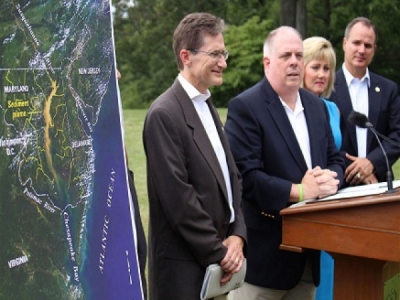
Posted on July 12, 2016
By Cheryl Mattix, Cecil Whig
Gov. Larry Hogan chose a cliff overlooking the Conowingo Dam to announce his administration’s sharpened focus on finding out more about the role Susquehanna River sediment plays in the pollution of the Chesapeake Bay.
In the Thursday afternoon speech, Hogan said his administration is eyeing potential dredging of the sediment that has reached its storage capacity behind the Conowingo Dam.
“It can’t trap any more sediment … I’ve said all along that Maryland should be leading the charge to clean up the Bay,” Hogan said, confirming his administration has been working on finding solutions for the last 17 months. “We must address the sediment issue, which has been ignored for years.”
After conducting Maryland’s first Conowingo Dam Summit at the Donaldson Brown Center in Port Deposit on Thursday, Hogan announced the formation of a multi-agency work group to seek innovative solutions to reduce pollution that threatens the Chesapeake Bay.
A formal request for information will serve as the tool to gather information from the private sector on potential solutions for the work group.
“By issuing this RFI, we are calling for innovative minds to step up with good ideas, so we can tackle this problem from all angles with everything we got,” Hogan said.
The Cecil County council members had already discussed the RFI during a work session last week when Council Manager Jim Massey called it to their attention after receiving a letter from Clean Chesapeake Coalition attorney Charles “Chip” MacLeod.
Bruce Michael, director of resource assessment service for the Maryland Department of Natural Resources, said last week that the RFI is to be completed by September.
“If the information warrants moving ahead, the state will issue a request for proposal for dredging,” he said.
Ron Fithian, chairman of the Clean Chesapeake Coalition, attended Thursday’s announcement along with MacLeod.
“This is a historic day,” Fithian said. “This is the single issue behind the formation of the Clean Chesapeake Coalition. I feel so good that our governor is not taking the easy way out. I think a lot of good things are coming.”
Fithian noted that all progress made to clean up the Chesapeake Bay could be lost with one large storm event, a common refrain from members of the coalition who believe stormwater containing sediment and debris plays a large role in the degradation of the Bay. The coalition was formed when former Gov. Martin O’Malley’s administration was looking at agriculture as one of the biggest contributors to pollution of the Chesapeake Bay, and it is funded by several Eastern Shore counties, including Cecil County.
Delegate Mary Ann Lisanti (D-Harford) was among several members of the Harford and Cecil county delegations that followed Hogan on his three-day tour of the area.
“This is gigantic,” Lisanti said, noting that for years she has believed that sediment behind the dam was a big issue, but nothing has happened until now.
Hogan emphasized the importance of Pennsylvania and New York getting involved in the effort to clean up the Chesapeake Bay.
“Pennsylvania in particular, but also New York, have a major role to play, and we’re going to try to make sure they are participants with us,” he told the Whig before his announcement Thursday. “We’ve had some encouraging preliminary discussions with Pennsylvania and we’re going to continue to press to see if we can get them involved. There’s going to be some upstream suggestions of things we can do in Pennsylvania.”
Following Thursday’s press conference, Maryland Secretary of the Environment Benjamin Grumbles said that greater cooperation between the Susquehanna River states of New York, Pennsylvania and Maryland will be needed to properly tackle the issue.
“It won’t be all sticks, we have to offer carrots as well,” he said. “We are in preliminary discussions with Pennsylvania about creating interstate nutrient credits. We want all our decisions to be driven by science and best data and we don’t want to rush it.”
“Exelon will also have to play a part in this,” Hogan added.
The governor explained that the work group is going to look at solutions, such as dredging, but also beneficial re-use of dredge materials. All of this activity is moving ahead during the re-licensing process for Exelon to operate the Conowingo Dam.
Grumbles noted that the re-licensing decision has been delayed once and indicated it could be delayed again if more time is needed to gather information.
Maryland issued Total Minimum Daily Load (TMDL) standards and goals in 2010, but the state must do a Mid-Point Assessment next year to determine how effective the program has been with an ultimate goal of cleaning up the Bay by 2025. Grumbles said the information gathered in the RFI would be helpful in the state’s revaluation, which gave the process a sense of urgency.
Earlier in the day, Hogan along with Maryland Department of Agriculture Secretary Joe Bartenfelder visited the Kilby Cream ice cream shop in Colora to sample some of its famous flavors. The governor spent time talking with owners Phyllis Kilby and Megan Coleman about their operation and Rising Sun town officials about municipal issues while enjoying a scoop of — what else — Maryland Madness ice cream.
Source: Cecil Whig





